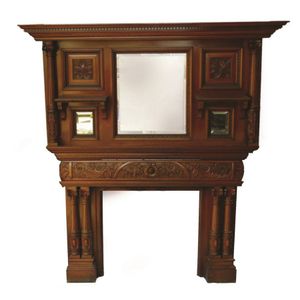Victorian Carved Fireplace Mantelpiece with Overmantel
You must be a subscriber, and be logged in to view price and dealer details.
Subscribe Now to view actual auction price for this item
When you subscribe, you have the option of setting the currency in which to display prices to $Au, $US, $NZ or Stg.
- Victorian Period - The Victorian period of furniture and decorative arts design covers the reign of Queen Victoria from 1837 to 1901. There was not one dominant style of furniture in the Victorian period. Designers used and modified many historical styles such as Gothic, Tudor, Elizabethan, English Rococo, Neoclassical and others, although use of some styles, such as English Rococo and Gothic tended to dominate the furniture manufacture of the period.
The Victorian period was preceded by the Regency and William IV periods, and followed by the Edwardian period, named for Edward VII (1841 ? 1910) who was King of the United Kingdom and the British Dominions and Emperor of India for the brief period from 1901 until his death in 1910. - Bevel / Chamfer - In furniture making, a chamfered corner refers to a technique used to create a smooth, angled edge on the corner of a piece of furniture. This is typically done by cutting away a small portion of the corner at an angle, typically 45 degrees, creating a diagonal edge, rather than a sharp 90-degree angle. This technique can be used on various parts of a piece of furniture such as table legs, drawer fronts, or door frames. Chamfering can add visual interest to a piece and can help to soften the overall look of a piece of furniture. It is often used in conjunction with other techniques, such as rounding edges or using contrasting wood species to create a more elegant, sophisticated look. Chamfering is a simple way to add a touch of elegance to a piece of furniture and it is a common technique used by furniture makers.
This item has been included into following indexes:
- fireplaces 99
Visually similar items

A fine Edwardian mahogany satinwood and fruitwood marquetry display cabinet on stand, with satinwood stringing overall, the triple arched pediment finely inlaid with scroll and foliate emblem, the sides with marquetry assemblage of instilments, the top res

An English Chippendale style walnut veneered cabinet, 20th century, the stepped and carved pelmet above two doors opening to reveal a fitted interior, above three drawers inset into the shaped apron, all raised on paw feet, 172.5 cm high, 102 cm wide, 57 c

An early Australian cedar twin pedestal sideboard, 100 x 204 x 62 cm

Arts & Crafts oak Gothic revival desk with inset green baize top, two frieze drawers, cupboard to one side enclosed by carved foliate panel door, twin spiral fluted uprights to the opposite end joined by a plain stretcher, original brass lock plates
